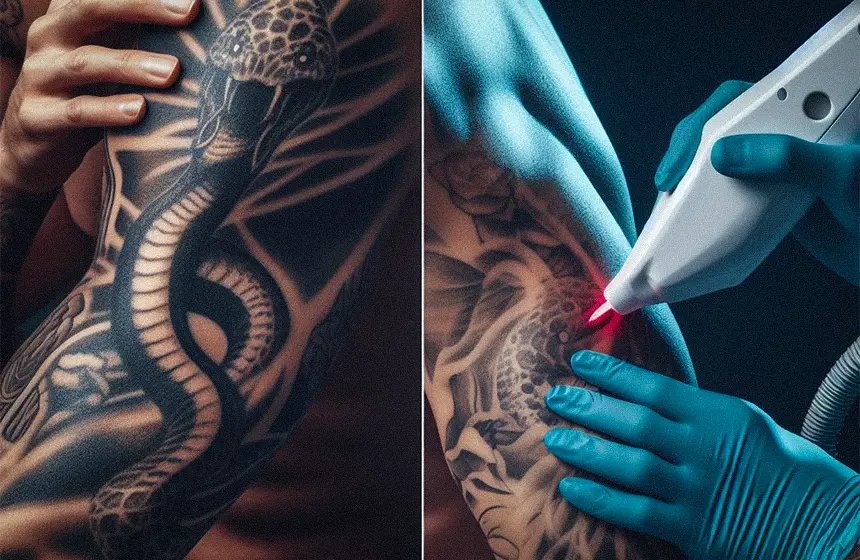You’re ready to erase that old tattoo. You’ve chosen laser removal, and now you’re wondering, ‘How many sessions to remove tattoo?’
It’s a complex answer, depending on your health, tattoo age, ink type, and size. Some tattoos might even need 20+ treatments.
But don’t worry. With each session, you’re closer to saying goodbye to your unwanted ink.
Let’s dive into the details.
Table of Contents
How Many Sessions To Remove Tattoo?
Usually, if you have a homemade tattoo or one done by someone who’s not a pro, it might take 3 to 7 sessions to remove it. But if you have a pro tattoo with strong inks, it could need 8 to 20 sessions to get rid of it.
Understanding Laser Tattoo Removal

You’ll need to grasp critical concepts to understand how laser tattoo removal works fully. This innovative technique uses specific wavelengths of light to break down the ink pigments beneath your skin. Factors influencing effectiveness include the tattoo’s age, colour, and location on your body, as well as your overall health.
The more vibrant the colours, the more treatments you’ll likely need. Additionally, older tattoos often require fewer sessions than newer ones. You should also be aware of potential side effects and risks. While laser tattoo removal is generally safe, it can cause skin discolouration or infection if not correctly cared for post-treatment.
Benefits of Laser Over Traditional Methods
In evaluating your tattoo removal options, it’s crucial to understand why laser technology’s benefits far outshine traditional methods like dermabrasion, cryosurgery, and excision.
Laser removal causes less damage to your skin, reducing the potential risks of scarring and infection. It offers a more precise removal, enabling the targeting of specific tattoo areas without affecting the surrounding skin.
From a cost comparison perspective, while the upfront cost of a laser might be higher, considering the reduced risk and better results, it offers better value for money. Additionally, it’s versatile and capable of removing different ink colours and depths.
The recovery time is significantly quicker with laser technology. Thus, the advantages of laser tattoo removal are clear and compelling.
Detailed Laser Tattoo Removal Process
It’s important to understand the detailed process of laser tattoo removal before committing.
The innovative procedure begins with the laser targeting your tattoo, producing a light that’s absorbed by the ink particles. This absorption causes a rapid thermal expansion of the ink particles, leading to their breakdown.
Now comes the role of white blood cells, which act as your body’s natural cleaning agents. They latch onto these fragmented particles, gradually removing them from the area over time.
This biological process is why multiple sessions are often needed for tattoo removal. Each session further destroys the ink particles, allowing your body’s white blood cells to remove more and more ink, eventually leading to tattoo-free skin.
Determining Required Removal Sessions
Given the crucial role your body’s health and the characteristics of your tattoo play, it’s hard to precisely determine how many sessions you’ll need for complete tattoo removal.
Various factors influence tattoo removals, such as your skin type, tattoo size, colour, and ink quality. Furthermore, the location of your tattoo and your immune system also play significant roles.
While a professional can provide an estimate, remember that everyone’s body responds differently to the process. Estimating the number of sessions needed is a different science. However, a good rule of thumb is to anticipate multiple sessions, often spanning several months.
Ultimately, patience, persistence, and a commitment to follow post-treatment care instructions are vital for successful tattoo removal.
Post-Treatment Expectations and Care
While you’re planning for the number of sessions needed for tattoo removal, it’s equally important to understand what to expect after each treatment and how to care for your skin.
Post-treatment results may vary, but generally, the tattoo lightens over multiple sessions. It’s essential to follow aftercare instructions to ensure optimal recovery. This includes avoiding sun exposure, staying hydrated, and applying prescribed ointments.
You may experience redness, swelling, and a sensation similar to a sunburn, but these are normal and temporary. Maintain a healthy lifestyle as your body plays a significant role in eliminating the fragmented ink particles.
Frequently Asked Questions
-
What Types of Tattoos Are More Difficult to Remove With Laser Treatment?
Ink depth and tattoo age significantly impact laser removal. Deeper, newer tattoos are more challenging to remove. They have denser ink, making them more resistant to laser breakdown. It’s a tough process, but it’s achievable.
-
Can Laser Tattoo Removal Completely Eliminate the Tattoo, or Will There Be a Trace Left?
Ink composition can impact laser tattoo removal’s effectiveness. It’s possible to fade, even eliminate, tattoos drastically. However, some traces might remain due to ink depth and type. Proper aftercare aids in optimal results.
-
Are There Any Potential Risks or Side Effects Associated With Laser Tattoo Removal?
You may experience temporary side effects post-laser tattoo removal, like redness or swelling. With evolving laser technology and proper aftercare procedures, risks are minimized, making the process safer and more effective.
-
How Painful Is the Laser Tattoo Removal Process Compared to the Tattoo Application?
You’ll find that laser tattoo removal can be more painful than the application. However, with effective pain management techniques and a proper aftercare regimen, discomfort can be significantly reduce during and after treatments.
-
Does the Color of the Skin Affect the Effectiveness of the Laser Tattoo Removal?
Yes, your skin pigmentation can impact laser efficiency in tattoo removal. Darker skin tones can absorb more laser energy, potentially reducing effectiveness and requiring more sessions for complete removal. It’s a complex process.
Conclusion
Tattoo removal isn’t a quick fix. It’s a journey. The number of sessions varies depending on your tattoo’s specifics and overall health.
It’s crucial to commit to the process and maintain post-treatment care. Remember, each session is progress, inching you closer to erasing your inked past.
With patience and dedication, you’ll soon be free of your unwanted tattoo. Trust the process and keep your end goal in sight.





